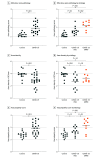Postmortem Assessment of Olfactory Tissue Degeneration and Microvasculopathy in Patients With COVID-19
- PMID: 35404378
- PMCID: PMC9002725
- DOI: 10.1001/jamaneurol.2022.0154
Postmortem Assessment of Olfactory Tissue Degeneration and Microvasculopathy in Patients With COVID-19
Abstract
Importance: Loss of smell is an early and common presentation of COVID-19 infection. Although it has been speculated that viral infection of olfactory neurons may be the culprit, it is unclear whether viral infection causes injuries in the olfactory bulb region.
Objective: To characterize the olfactory pathology associated with COVID-19 infection in a postmortem study.
Design, setting, and participants: This multicenter postmortem cohort study was conducted from April 7, 2020, to September 11, 2021. Deceased patients with COVID-19 and control individuals were included in the cohort. One infant with congenital anomalies was excluded. Olfactory bulb and tract tissue was collected from deceased patients with COVID-19 and appropriate controls. Histopathology, electron microscopy, droplet digital polymerase chain reaction, and immunofluorescence/immunohistochemistry studies were performed. Data analysis was conducted from February 7 to October 19, 2021.
Main outcomes and measures: (1) Severity of degeneration, (2) losses of olfactory axons, and (3) severity of microvasculopathy in olfactory tissue.
Results: Olfactory tissue from 23 deceased patients with COVID-19 (median [IQR] age, 62 [49-69] years; 14 men [60.9%]) and 14 control individuals (median [IQR] age, 53.5 [33.25-65] years; 7 men [50%]) was included in the analysis. The mean (SD) axon pathology score (range, 1-3) was 1.921 (0.569) in patients with COVID-19 and 1.198 (0.208) in controls (P < .001), whereas axon density was 2.973 (0.963) × 104/mm2 in patients with COVID-19 and 3.867 (0.670) × 104/mm2 in controls (P = .002). Concomitant endothelial injury of the microvasculature was also noted in olfactory tissue. The mean (SD) microvasculopathy score (range, 1-3) was 1.907 (0.490) in patients with COVID-19 and 1.405 (0.233) in control individuals (P < .001). Both the axon and microvascular pathology was worse in patients with COVID-19 with smell alterations than those with intact smell (mean [SD] axon pathology score, 2.260 [0.457] vs 1.63 [0.426]; P = .002; mean [SD] microvasculopathy score, 2.154 [0.528] vs 1.694 [0.329]; P = .02) but was not associated with clinical severity, timing of infection, or presence of virus.
Conclusions and relevance: This study found that COVID-19 infection is associated with axon injuries and microvasculopathy in olfactory tissue. The striking axonal pathology in some cases indicates that olfactory dysfunction in COVID-19 infection may be severe and permanent.
Conflict of interest statement
Figures




References
Publication types
MeSH terms
Grants and funding
LinkOut - more resources
Full Text Sources
Medical
Miscellaneous

